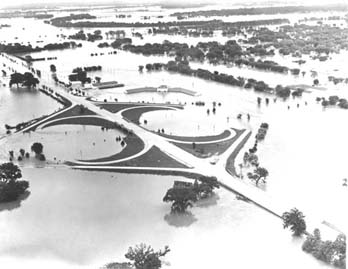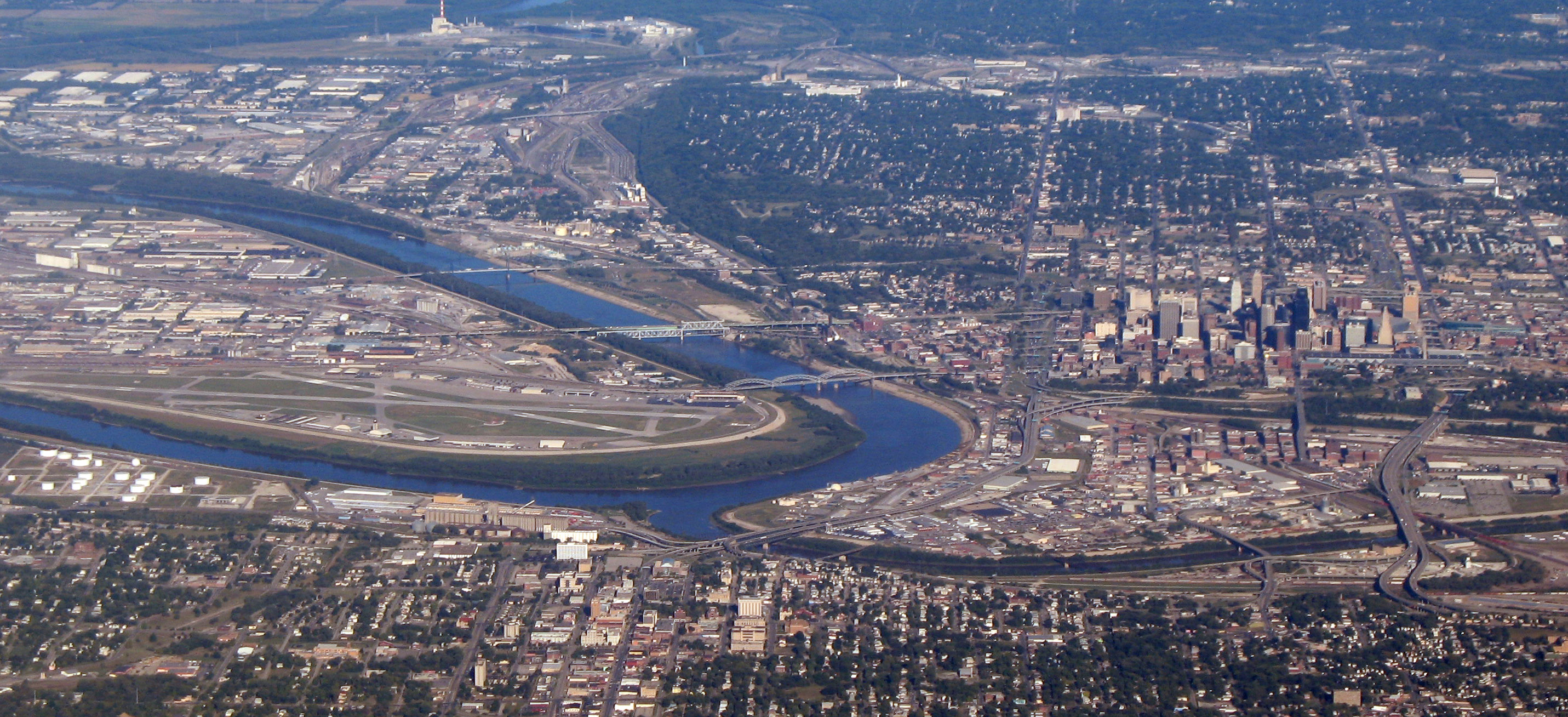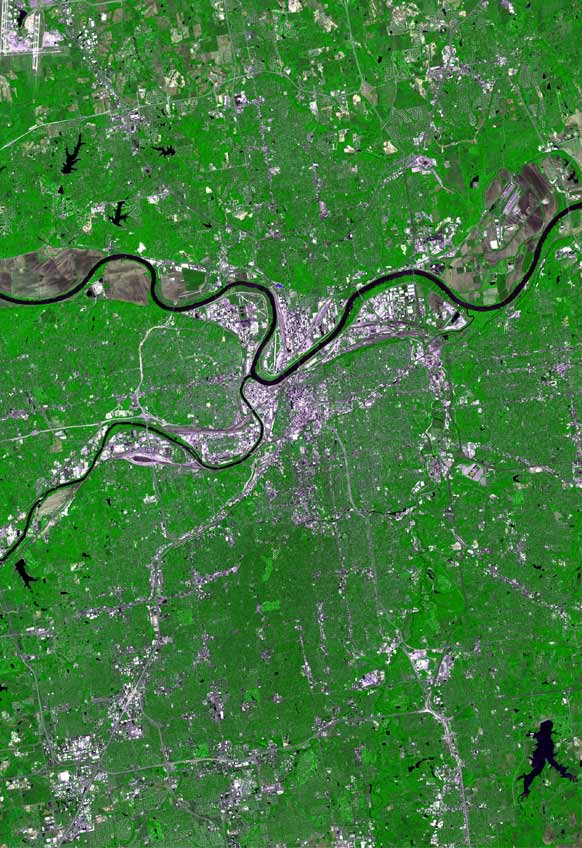|
Great Flood Of 1951
In mid-July 1951, heavy rains led to a great rise of water in the Kansas River, Missouri River, and other surrounding areas of the Central United States. Flooding occurred in the Kansas, Neosho, Marais Des Cygnes, and Verdigris river basins. The damage in June and July 1951 across eastern Kansas and Missouri exceeded (equivalent to $ in ). The flooding killed 17 people and displaced 518,000 more. Flood The 1951 flood in Kansas began in May with the flood of the Big Creek, (a tributary of the Smoky Hill River) in Hays after eleven inches of rain in two hours. The creek overflowed, flooding Hays (the location of Fort Hays State University) to a depth of four feet in most locations inhabited by the coeds on campus, necessitating a midnight flight from the barracks (by families of the G.I. Bill) and dorms to the Stadium's third floor, which was still dry. Dr. Charles F. Wiest, Emeritus Professor of Philosophy and Religion, and his seven-year-old daughter perished when their h ... [...More Info...] [...Related Items...] OR: [Wikipedia] [Google] [Baidu] |
Bonner Springs, Kansas
Bonner Springs is a city in Wyandotte, Leavenworth, and Johnson counties, Kansas, United States. It is part of the Kansas City Metropolitan Area. As of the 2020 census, the population of the city was 7,837. Bonner Springs was incorporated as a city on November 10, 1898. Bonner Springs is home to the Azura Amphitheater (commonly known as the Sandstone Amphitheater), the National Agricultural Center and Hall of Fame, Wyandotte County Historical Museum, and the annual Kansas City Renaissance Festival. History Early settlers The Kanza people had settled the area because of the mineral springs and abundant fish and game when, in 1812, two French fur traders, the Chouteau brothers, made their way from St. Louis and temporally settled in the area that would eventually become Bonner Springs, starting a trading post named "Four Houses". The location allowed easy access to trade items, and a ferry to cross the Kansas River was added. With a date of 1812, it is reputed to be the fi ... [...More Info...] [...Related Items...] OR: [Wikipedia] [Google] [Baidu] |
Kansas City, Kansas
Kansas City, abbreviated as "KCK", is the third-largest city in the U.S. state of Kansas, and the county seat of Wyandotte County. It is an inner suburb of the older and more populous Kansas City, Missouri, after which it is named. As of the 2020 census, the population of the city was 156,607, making it one of four principal cities in the Kansas City metropolitan area. It is situated at Kaw Point, the junction of the Missouri and Kansas rivers. It is part of a consolidated city-county government known as the "Unified Government". It is the location of the University of Kansas Medical Center and Kansas City Kansas Community College. History In October 1872, "old" Kansas City, Kansas, was incorporated. The first city election was held on October 22 of that year, by order of Judge Hiram Stevens of the Tenth Judicial District, and resulted in the election of Mayor James Boyle. The mayors of the city after its organization were James Boyle, C. A. Eidemiller, A. S. Orbison, ... [...More Info...] [...Related Items...] OR: [Wikipedia] [Google] [Baidu] |
Fairfax Airport
Fairfax Municipal Airport (known as Fairfax Field during World War II) was a Kansas City, Kansas airfield from 1921 that was used during 1935–1949 by the military. Federal land adjacent to the airfield included a WWII B-25 Mitchell plant and modification center and a Military Air Transport terminal. After being used as a Cold War-era Air Force Base, it was used for airliner servicing by TWA and for automobile and jet fighter aircraft production by General Motors, which built General Motors Fairfax Assembly Plant, a 1985 Fairfax Plant over runways when the municipal airport closed. Background The airport site is on the Goose Island (Kansas) river bend. At Goose Island, the Federal government of the United States, United States Government constructed flood protection levees and walls around the Fairfax Industrial District, as well as three pump houses including two on the airfield that was first used for a 1921 "American Legion air meet". The airfield was subsequently used b ... [...More Info...] [...Related Items...] OR: [Wikipedia] [Google] [Baidu] |
West Bottoms
The West Bottoms is an industrial area immediately to the west of downtown Kansas City, Missouri. Located in Kansas City, Missouri and Kansas City, Kansas it sits at the confluence of the Missouri River and the Kansas River. The area is one of the oldest areas of the cities. While the West Bottoms is still home to several industrial buildings today, its antique shops and haunted houses are very popular. Additionally, there are several art galleries and restaurants located in the West Bottoms, and a few companies have offices in the area. History Kansas City's first Union Depot was located here. It was home to the Kansas City Live Stock Exchange and Kansas City Stockyards (now defunct) prompting the huge annual American Royal livestock show at Kemper Arena, the site of the 1976 Republican National Convention. Additionally, The West Bottoms was home to large industrial district which produced plows and tractors starting in the 1870s. Many of the factory buildings still st ... [...More Info...] [...Related Items...] OR: [Wikipedia] [Google] [Baidu] |
Kansas City Stockyards
The Kansas City Stockyards in the West Bottoms west of downtown Kansas City, Missouri flourished from 1871 until closing in 1991. Jay B. Dillingham was the President of the stockyards from 1948 to its closing in 1991. History The stockyards were built to provide better prices for livestock owners. Previously, livestock owners west of Kansas City could only sell at whatever price the railroad offered. With the Kansas City Livestock Exchange and the Stockyards, cattle were sold to the highest bidder. The stockyards were built around the facilities of the Central Overland California and Pikes Peak Express Company which had outfitted travelers on the Santa Fe Trail and Oregon Trail following the Kansas River. The company went out of business in 1862 following the failure of its Pony Express business from St. Joseph, Missouri, to Sacramento, California. The stockyards were established in 1871 on the Kansas side of the Kansas River along the Kansas Pacific and Missouri Pacifi ... [...More Info...] [...Related Items...] OR: [Wikipedia] [Google] [Baidu] |
Armourdale, Kansas
Armourdale community is a district in the lower part of the Kansas River valley in Kansas City, Kansas. It is a main district between the West Bottoms and the Rosedale, Kansas area. The Kansas River makes an oxbow curve around the entire district, which is home to Shawnee Park and Bill Clem Park. History Armourdale was platted in 1880, and incorporated as a city in 1882. Its name came from the Armour meatpacking plant in the area. In March 1886, "new" Kansas City, Kansas was formed through the consolidation of five municipalities: "old" Kansas City, Armstrong, Armourdale, Riverview, Wyandotte. The district was devastated by the 1903 Kansas City flood, and again in the flood of 1951, with damage adding up to about 50 million dollars that year. The 1993 flood, however, did no damage as the new floodwalls held up, and protected Armourdale from waters. Demographics It is home mainly to Mexican Americans, and many small and large companies in its east side. Bridges * 23rd St ... [...More Info...] [...Related Items...] OR: [Wikipedia] [Google] [Baidu] |
Argentine, Kansas
Argentine is a community of Kansas City, Kansas, located in the southern part of Wyandotte County. It is bordered on the west by the Turner community, on the east by the Rosedale community, on the south by Johnson County, and on the north by Armourdale community and by the Kansas River. Argentine was primarily recognized for the prosperous silver smeltery for which it was named. Built on the site of a former Shawnee reservation, the proximity of the railroad, local lumber sources, the smeltery, and in later years, steel manufacturing, meant that the city enjoyed a considerable amount of economic success for quite some time. When the smeltery finally closed, the city found itself in the throes of an unprecedented financial crisis and began to seek entry to nearby Kansas City in 1907. Although the community was annexed and became the seventh ward of Kansas City, Kansas in 1910, the neighborhood retains its own distinct flavor and personality. Prominent nearby landmarks includ ... [...More Info...] [...Related Items...] OR: [Wikipedia] [Google] [Baidu] |
Kansas City Metropolitan Area
The Kansas City metropolitan area is a bi-state metropolitan area anchored by Kansas City, Missouri. Its 14 counties straddle the border between the U.S. states of Missouri (9 counties) and Kansas (5 counties). With and a population of more than 2.2 million people, it is the second-largest metropolitan area centered in Missouri (after Greater St. Louis) and is the largest metropolitan area in Kansas, though Wichita is the largest metropolitan area centered in Kansas. Alongside Kansas City, Missouri, these are the suburbs with populations above 100,000: Overland Park, Kansas; Kansas City, Kansas; Olathe, Kansas; Independence, Missouri; and Lee's Summit, Missouri. Business enterprises and employers include Cerner Corporation (the largest, with almost 10,000 local employees and about 20,000 global employees), AT&T, BNSF Railway, GEICO, Asurion, T-Mobile (formerly Sprint), Black & Veatch, AMC Theatres, Citigroup, Garmin, Hallmark Cards, Waddell & Reed, H&R Block, Ge ... [...More Info...] [...Related Items...] OR: [Wikipedia] [Google] [Baidu] |
Lawrence, Kansas
Lawrence is the county seat of Douglas County, Kansas, Douglas County, Kansas, United States, and the sixth-largest city in the state. It is in the northeastern sector of the state, astride Interstate 70, between the Kansas River, Kansas and Wakarusa River, Wakarusa Rivers. As of the 2020 United States census, 2020 census, the population of the city was 94,934. Lawrence is a college town and the home to both the University of Kansas and Haskell Indian Nations University. Lawrence was founded by the New England Emigrant Aid Company (NEEAC) and was named for Amos A. Lawrence, an abolitionist from Massachusetts, who offered financial aid and support for the settlement. Lawrence was central to the "Bleeding Kansas" period (1854–1861), and the site of the Wakarusa War (1855) and the Sacking of Lawrence (1856). During the American Civil War it was also the site of the Lawrence massacre (1863). Lawrence began as a center of Free-Stater (Kansas), free-state politics. Its economy diver ... [...More Info...] [...Related Items...] OR: [Wikipedia] [Google] [Baidu] |
Topeka, Kansas
Topeka ( ; Kansa: ; iow, Dópikˀe, script=Latn or ) is the capital city of the U.S. state of Kansas and the seat of Shawnee County. It is along the Kansas River in the central part of Shawnee County, in northeast Kansas, in the Central United States. As of the 2020 census, the population of the city was 126,587. The Topeka metropolitan statistical area, which includes Shawnee, Jackson, Jefferson, Osage, and Wabaunsee Counties, had a population of 233,870 in the 2010 census. The name "Topeka" is a Kansa-Osage word that means "place where we dig potatoes", or "a good place to dig potatoes". As a placename, Topeka was first recorded in 1826 as the Kansa name for what is now called the Kansas River. Topeka's founders chose the name in 1855 because it "was novel, of Indian origin, and euphonious of sound."King, Dick (20 Nov. 2005)Topeka' rooted in spuds". ''Topeka Capital-Journal'' Mixed-blood Kaw people, Kansa Native American, Joseph James, called Jojim, is cred ... [...More Info...] [...Related Items...] OR: [Wikipedia] [Google] [Baidu] |
Downtown
''Downtown'' is a term primarily used in North America by English speakers to refer to a city's sometimes commercial, cultural and often the historical, political and geographic heart. It is often synonymous with its central business district (CBD). Downtowns typically contain a small percentage of a city’s employment. In some metropolitan areas it is marked by a cluster of tall buildings, cultural institutions and the convergence of rail transit and bus lines. In British English, the term "city centre" is most often used instead. History Origins The Oxford English Dictionary's first citation for "down town" or "downtown" dates to 1770, in reference to the center of Boston. Some have posited that the term "downtown" was coined in New York City, where it was in use by the 1830s to refer to the original town at the southern tip of the island of Manhattan.Fogelson, p. 10. As the town of New York grew into a city, the only direction it could grow on the island was toward the nor ... [...More Info...] [...Related Items...] OR: [Wikipedia] [Google] [Baidu] |






